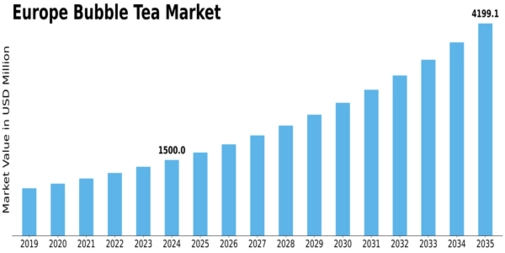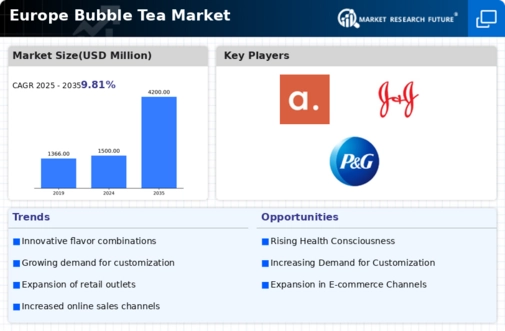Europe Bubble Tea Size
Europe Bubble Tea Market Growth Projections and Opportunities
The Europe bubble tea market is influenced by several key factors that shape its growth, trends, and consumer demand. One significant factor is the increasing popularity of Asian cuisine and beverages across Europe. As globalization and cultural exchange continue to flourish, European consumers are becoming more adventurous in their culinary tastes, seeking out exotic flavors and experiences. Bubble tea, with its origins in Taiwan, has gained traction in European countries, capturing the interest of consumers drawn to its unique combination of tea, milk, and tapioca pearls, as well as a variety of flavor options, including fruit and herbal infusions.
Changing consumer preferences and lifestyle trends also play a crucial role in driving the Europe bubble tea market. As consumers increasingly prioritize health and wellness, there is a growing demand for beverages that are perceived as natural, fresh, and customizable. Bubble tea, which can be made with natural tea leaves, fresh fruit, and other wholesome ingredients, appeals to health-conscious consumers seeking alternatives to sugary sodas and artificially flavored drinks. Moreover, the customizable nature of bubble tea allows consumers to adjust sweetness levels, choose dairy-free options, or add additional toppings to suit their dietary preferences and taste preferences.
The influence of social media and digital culture is another significant market factor in the Europe bubble tea industry. Platforms like Instagram, TikTok, and YouTube have played a crucial role in popularizing bubble tea and driving consumer awareness and demand. Influencers and content creators share visually appealing photos, videos, and tutorials featuring colorful and photogenic bubble tea drinks, sparking curiosity and generating buzz among their followers. Additionally, online reviews, recommendations, and user-generated content contribute to the viral spread of bubble tea culture, creating a sense of FOMO (fear of missing out) among consumers eager to try the latest food and beverage trends.
Marketing and branding strategies also play a crucial role in shaping consumer perceptions and driving demand in the Europe bubble tea market. Companies invest in creative packaging, branding, and promotional campaigns to differentiate their bubble tea offerings and stand out in a competitive market. Eye-catching logos, vibrant colors, and playful branding help attract consumers' attention and communicate the fun and youthful appeal of bubble tea. Moreover, engaging consumers through social media marketing, influencer partnerships, and experiential events helps build brand awareness and foster consumer loyalty.
Distribution channels impact the Europe bubble tea market, influencing accessibility and consumer reach. While bubble tea was once primarily sold through Asian specialty shops or dedicated bubble tea cafes, it has now become more mainstream, with bubble tea franchises and pop-up shops expanding their presence in major European cities. Additionally, supermarkets, convenience stores, and online retailers offer packaged bubble tea kits or ready-to-drink options, providing consumers with convenient access to their favorite bubble tea flavors. This wider distribution network ensures that bubble tea is readily available to a broader audience of consumers, driving market growth and increasing consumer awareness and adoption of bubble tea products.
Government regulations and food safety standards also influence the Europe bubble tea market. Regulatory bodies set guidelines for the production, handling, and labeling of food and beverages to ensure consumer safety and transparency. Compliance with these regulations is essential for bubble tea manufacturers and retailers to maintain product quality, safety, and consumer trust. Additionally, adherence to certifications such as organic or fair trade may help differentiate bubble tea products and appeal to health-conscious and socially responsible consumers.
Competitive dynamics and market trends drive innovation and product differentiation in the Europe bubble tea market. With an increasing number of players entering the market, competition is intensifying, leading to a greater variety of bubble tea flavors, toppings, and customization options. Companies differentiate themselves by offering unique flavor combinations, premium ingredients, and innovative packaging designs that stand out on store shelves and appeal to discerning consumers. Moreover, innovation in dairy-free options, low-sugar formulations, and eco-friendly packaging further contributes to product diversification and market competitiveness.
Consumer behavior and preferences continue to evolve, shaping the dynamics of the Europe bubble tea market. While some consumers prioritize novelty and variety, others prioritize health, sustainability, and ethical sourcing in their beverage choices. Understanding these preferences and market trends is essential for bubble tea manufacturers and retailers to develop targeted marketing strategies, product offerings, and distribution channels that resonate with their target audience. Consumer education initiatives highlighting the health benefits, sustainability practices, and cultural significance of bubble tea help increase awareness and drive demand in the Europe market.








Leave a Comment